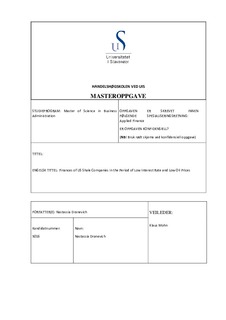| dc.contributor.advisor | Mohn, Klaus | |
| dc.contributor.author | Dranevich, Nastassia | |
| dc.date.accessioned | 2018-09-19T09:52:28Z | |
| dc.date.available | 2018-09-19T09:52:28Z | |
| dc.date.issued | 2018-06 | |
| dc.identifier.uri | http://hdl.handle.net/11250/2563397 | |
| dc.description | Master's thesis in Applied Finance | nb_NO |
| dc.description.abstract | The recent significant tendencies in the oil industry was studied by many researchers. The shift of oil supply-demand equilibrium, consequent oil price plunge had a prolonged effect on the oil and gas sector all over the world. All the players in the industry were affected and experienced various impact levels. Weakened balance sheets, enormous restructuring programs, bankruptcy were the new reality of the most oil companies.
One of the determinative factors leading to the global change in the oil industry was the development of shale oil in the US. The phenomenon of “Shale Oil Boom” or “Shale Oil Revolution” is quite specific and has fascinated industry players.
The new technologies used, and financial characteristics of the shale oil projects lead to profitability gains and quick growth of production scope. Even the sharp drop in commodities prices didn’t have a significant effect on the production volumes of the US exploration and production firms. The question of source of funding the constant growth in production of shale oil companies is a point of great interest. The recent researches have showed that the US oil companies have high gearing levels, meaning that the debt financing, accompanied by low interest rates set by the Fed, became the mode of survival for the most E&P companies.
We started our work with the look at the shale oil development and its major consequences. Further we focused on the analysis of two US E&P companies, Anadarko Petroleum and Eclipse Resources, differed by the scope of operations, level of reserves, the life-cycle stage, credit ratings, position in the market etc. to identify in more practical way the main trends in the oil sector for the last five years.
The analysis performed demonstrated the significant decrease in profitability measures and increase in the leverage ratios, as well as the strong deficit in free cash flows for the E&P companies in the last five years regardless of their size or life-cycle stage. The analysis indicated that the years with the strongest free cash flows deficit coincided with the largest increases in the total debt of both Anadarko Petroleum and Eclipse Resources, proving the strong demand for debt and the dependence of the US shale companies on the debt as the main source of financing. The sensitivity analysis identified the strong effect of the change in the interest rates level, which is more significant for the small shale companies with below investment grade ratings.
We believe our work to be informative and comparative tool for further researches. | nb_NO |
| dc.language.iso | eng | nb_NO |
| dc.publisher | University of Stavanger, Norway | nb_NO |
| dc.relation.ispartofseries | Masteroppgave/UIS-HH/2018; | |
| dc.rights | Navngivelse 4.0 Internasjonal | * |
| dc.rights | Navngivelse 4.0 Internasjonal | * |
| dc.rights.uri | http://creativecommons.org/licenses/by/4.0/deed.no | * |
| dc.subject | økonomi | nb_NO |
| dc.subject | administrasjon | nb_NO |
| dc.subject | anvendt finans | nb_NO |
| dc.subject | shale oil | nb_NO |
| dc.subject | us shale oil companies | nb_NO |
| dc.title | Finances of US Shale Companies in the Period of Low Interest Rate and Low Oil Prices | nb_NO |
| dc.type | Master thesis | nb_NO |
| dc.subject.nsi | VDP::Samfunnsvitenskap: 200::Økonomi: 210::Samfunnsøkonomi: 212 | nb_NO |

